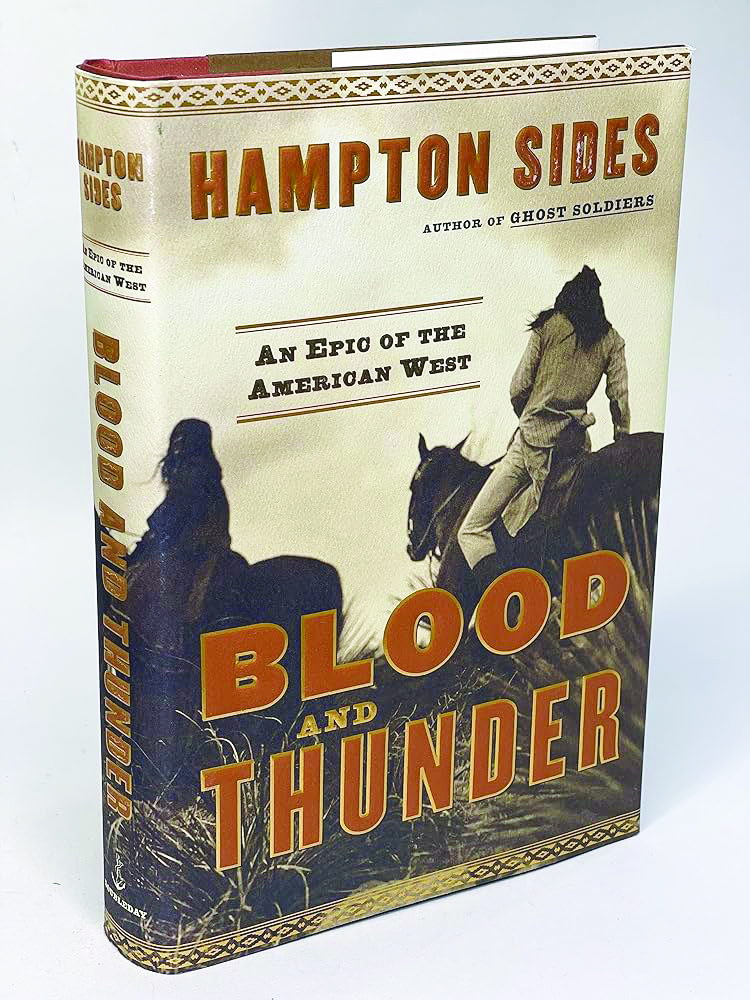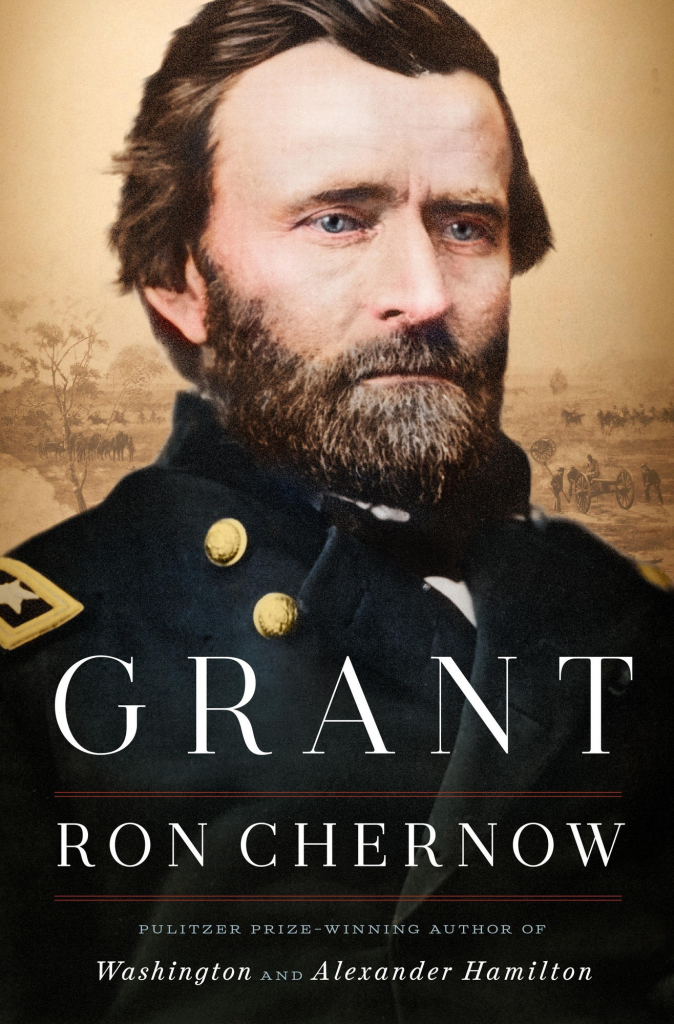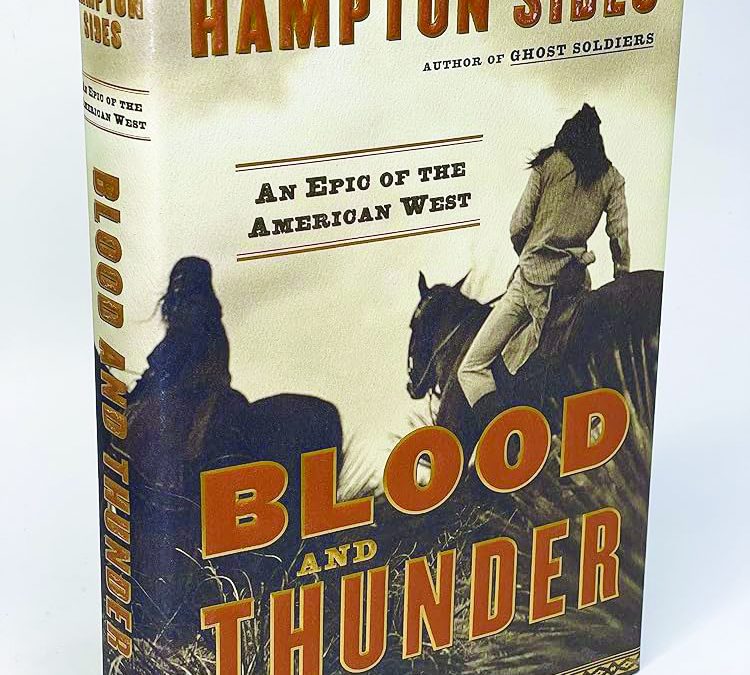In Blood and Thunder: The Epic Story of Kit Carson and the Conquest of the American West (2006), renowned narrative historian Hampton Sides introduces us to an extraordinary man whose legendary and myth-inspiring exploits span over three decades of American expansion under the banner of “Manifest Destiny.”

In 1826, a 16-year-old fellow named Christopher “Kit” Carson headed west from the brand new state of Missouri, as Sides writes, with “a large merchant caravan heading west to Santa Fe. ‘Well, what do you have to say for yourself?’ the caravan leader asked Carson when he applied for the job. ‘Nothing’ Carson replied, ‘except I can shoot straight.’”
Engaging in the full richness of an American story such as this requires a general understanding of the manner in which the United States expanded its territory; from a few million citizens largely collected upon the eastern seaboard of North America, into a continent-spanning force that came to largely influence the affairs of the entire western hemisphere. I refer to the map depicting this growth as a “jigsaw puzzle” of American territorial expansion. Understanding the basics of each “piece” goes a long way to putting the many stories of the nation’s history into perspective.
Although this map plots the geographic growth of the United States, it is critical to note that this expansion was carried out across a continent once inhabited by as many as 18,000,000 Native Americans. Indeed, as you’ll see, Kit Carson’s relationship with many of these tribes is an important part of his story.
To begin, the original 13 colonies declared independence from Great Britain in 1776. The western boundary was placed roughly at the Appalachian Mountains. Victory in The American Revolution affirmed Great Britain’s recognition of the United States with a western boundary that—according to the Treaty of Paris, 1783—extended to the Mississippi River. The first piece of the American territorial “jigsaw puzzle” was now firmly in place.
In 1803, France sold the Louisiana Territory to the United States, as Napoleon Bonaparte gave up his dreams of a North American empire. The result was a literal doubling of the size of the United States at a price of about 4 cents per acre. This purchase put the western border of the nation at the Rocky Mountains, although much of this territory had yet to be mapped. The Louisiana Purchase was acquired the same year that Lewis and Clark and the Corps of Discovery headed west to do just that.
As the Spanish empire to the west and south was threatened with a series of independence movements throughout Latin America, 1819 saw the United States step in and take Florida off Spain’s hands; this, in return for agreeing to the border between Spanish territory and the Louisiana Purchase.
After Mexico won its independence from Spain in 1821, Mexico and the US shared this border. The map tells us clearly that when Kit Carson set forth from Missouri in 1826 he was heading into Mexico; lands recently held by Spain that were also the ancestral lands of socially and economically diverse groups of Native American peoples. In this rich environment, Carson would help lay the groundwork for the millions of white settlers that followed in his wake.

In his first 15 years in the West, Carson learned the ways of the mountain man. He learned how to trap beavers and prepare their pelts for sale. He learned to hunt buffalo, deer, and antelope and to build shelters in remote places. He learned Spanish and French, and could communicate in a variety of Native American languages, even though he could neither read nor write. His travels took him far south into Mexico, north throughout the Rocky Mountains, and West to California (also part of Mexico).
In many ways, Kit Carson defied the stereotype of the mountain man. He was not a big drinker or gambler. “He stood only five-feet four-inches,” Sides writes, “with stringy brown hair grazing his shoulders… he appeared bow legged from his years in the saddle, and walked roundly, with a certain ungainliness, as though he were not entirely comfortable as a terrestrial creature, his sense of ease and familiarity of movement tied to his mule.”
He was not violent unless violence was called for. He was no braggart; after “dispatching a hostile Indian” (as Carson saw it) in northern California, Carson said, “I dismounted and fired. My shot had the desired effect.” In another story, Sides writes that “a band of Blackfeet stole a season’s worth of [Carson’s beaver] pelts. To the mountain man, this was an act of war.” In a classic act of righteous vengeance, Carson recounted later, “It was three years before we could get back and thank them. But our time came, and we left mourning in their tribe.”
But Carson was no Indian hater. He saw Comanche, Apache, Navajo, and dozens of other Native American tribes as distinct with their own unique interests and proclivities. His first wife was Singing Grass, a young Arapaho woman who he met while attending a rendezvous gathering of mountain men in 1835.
In 1842, after the beaver trade had collapsed, Carson signed on as a guide for John C. Fremont; leader of the US Army’s topographical engineers. Over the course of his first three expeditions from 1842-1845 Fremont mapped out much of the West including the Rocky Mountains, to the Great Salt Lake and into the Oregon country. He mapped out the Cascade and Sierra Nevada mountain ranges. He traveled into California, and through what is now Nevada and Utah.
Along the way, Fremont created a detailed record of his findings including flora, fauna, and topographic information. His reports were filled with maps and drawings and became widely published guidebooks for the waves of migration that populated the West with American settlers. Fremont held Carson in high esteem and duly recorded many thoughts about the mountain man’s exploits, his character, and his courage. And Fremont’s reports eventually transformed this often-humble man into a national hero.
As early as the 1830s, the idea was beginning to take hold that the United States was destined to spread its ideas of liberty across the continent to the Pacific Ocean; although it wasn’t until 1845 or so that the term “Manifest Destiny” was coined.
With many believing that it was God’s will that the United States should expand, that 1821 border between Mexico and the United States didn’t last long. After Texans—white American and largely Protestant slaveholding settlers—fought for their independence from largely Catholic Mexico in 1836, Texas agreed to join the United States in 1845. Mexico wasn’t too happy about this but was in no real position to resist when President James K. Polk provoked them into a war.

You may also enjoy this article by Jimmy P. Morgan “Uncle Joe”
It was Polk who sent John C. Fremont on his third expedition with what is believed to be secret instructions to turn his surveying party into a military force. With Kit Carson at his side, Fremont’s venture into Mexican California encouraged the Americans there to resist Mexican rule. This occurred just as events in Texas kicked off the war. Fremont ordered Carson to carry dispatches of his California success to Washington, DC.
As it turns out, on his effort to travel to the nation’s capital in sixty days, Carson ran into General Stephen Watts Kearny leading the Army of the West. With 1700 regular and volunteer troops, Kearny had marched to Santa Fe and upon his arrival proclaimed to the town, “I have come amongst you by the orders of my government to take possession of your country.” As Hampton Sides writes, “Seldom in history had so much real estate been seized by the simple act of a few men walking over it.”
After leaving Santa Fe in the hands of the beginnings of an American government, Kearny made his way to California with less than a hundred men. The troops encountered a much larger contingent of the Mexican army and Kearny and his men, many of them wounded, became pinned down and surrounded. Carson’s trip to Washington was over, Kearny ordered the mountain man back west with messages of his own; pleading with Commodore Robert F. Stockton to send help. Stockton commanded the US naval forces in the Pacific and had been charged with taking control of southern California.
Having removed his boots to stealthily get past the surrounding Mexicans, Kit Carson and two volunteers walked barefooted dozens of miles to deliver Kearny’s distress call; which Stockton heeded with all success.
About the same time, in the northwest, which Carson had helped to map with John C. Fremont, and with American success against Mexico all but inevitable, Great Britain settled a dispute with the United States to divide the Oregon Country in 1846; sliding in one more piece of the American territorial expansion jigsaw puzzle into place.
With an expansionist president and “God on their side,” it came as no surprise that, not only did an American victory over Mexico affirm Texas as part of the US; the Treaty of Guadalupe Hidalgo in 1848 determined that Mexico also ceded what are now California, Nevada, and parts of Arizona, Colorado and New Mexico.
A few years later, in 1853, after realizing a southern transcontinental railroad would more easily be built in the northern reaches of Mexico’s new border, the US paid Mexico 10 million dollars for the Gadsden Purchase… in what I like to describe as a “deal they couldn’t refuse.”
The territory of what would eventually become the lower 48 states was largely in the possession of the United States by 1853.
During the 1850s, as an officer in the US Army, Carson served as an Indian agent for which he was particularly well-suited. However, his superiors often held less-enlightened positions in regards to Native Americans. In several instances, Carson acted against his own better judgment while giving deference to following orders. Hampton Sides documents these moments with academic and scholarly objectivity. While the historian clearly admires Kit Carson, he doesn’t fail to point out that Manifest Destiny is first and foremost a story of conquest; one in which Kit Carson, reluctantly or not, played his part. In 1864, for example, Carson was compelled to force about 8,000 Navajo Indians from their ancestral homeland on a forced march of hundreds of miles to a reservation. It did not turn out well.
By this time, reports of Carson’s adventures had been widely reported. In many cases, his stories were told by writers with little real knowledge of Kit Carson. At one point, after hearing a reporter’s account of his activities, Carson said, “Some of these newspaper fellows… know more about my affairs than I do.”
A number of widely published books known as “blood and thunders” greatly exaggerated events of Carson’s life. Despite this, and largely due to the fine scholarship of Hampton Sides, we see that many of the verified adventures of Kit Carson hold their own against the myths.
When the Civil War broke out Carson was appointed Lieutenant Colonel by the territorial governor of New Mexico and charged with organizing the First New Mexico Volunteers. He participated in defending New Mexico—and thus California—from an invading Confederate force of Texans. The Union victories in the Battle of Valverde and the Battle of Glorieta Pass ended the Confederacy’s efforts to establish a foothold in the West.
Kit Carson didn’t draw the American map of territorial expansion but he was, as Sides writes, “there at the creation, it seemed. He had witnessed the dawn of the American West in all its vividness and brutality. In his constant travels he had caromed off of or intersected with nearly every major tribal group and person of consequence.”Check out this YouTube episode of Into the Wild Frontier for a brief low budget yet thoughtful and accurate portrait of Kit Carson. https://tinyurl.com/y5uadzr5












